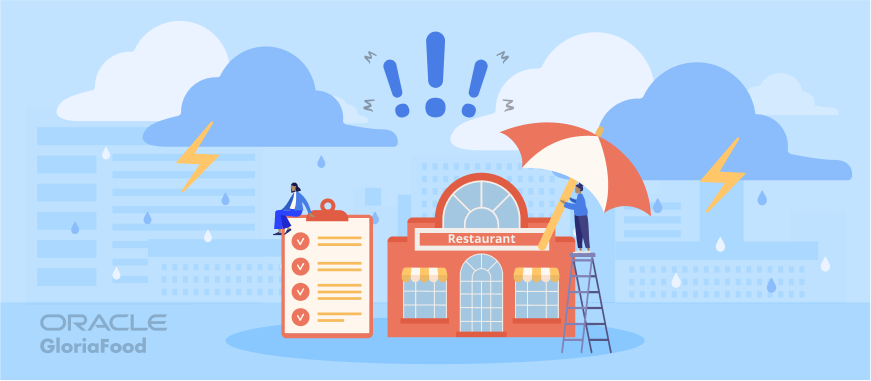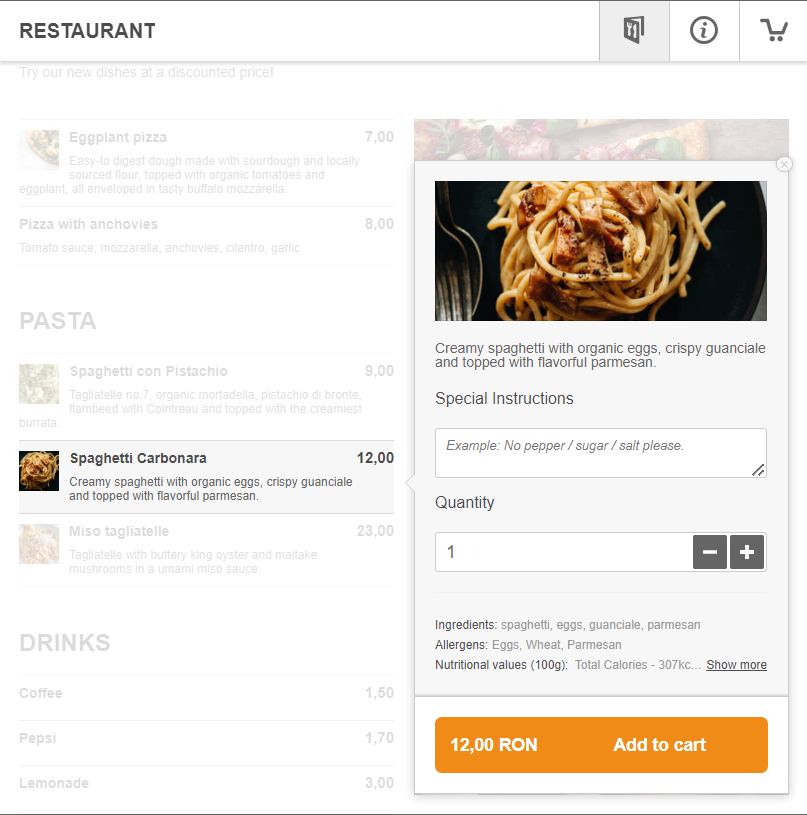- 1.Train employees on proper food safety
- 2.Establish and practice emergency procedures
- 3.Offer staff protective attire
- 4.Ensure floors are clean at all times
- 5.Handle equipment with care
- 6.Have a strict cleaning schedule
- 7.Store food efficiently
- 8.Use separate areas for allergen-safe foods
- 9.Provide adequate ventilation for all spaces
- 10.Monitor employee health
Did you know that 800 food-borne illness outbreaks are reported to the CDC annually? And that 60% of them are linked to restaurants? A client getting sick from your food can lead not only to bad reviews and big fines but also to closure.
If you want to run a restaurant that is appreciated by the community, you need to take measures and ensure safety in each aspect, from the kitchen’s cleanliness to the staff’s well-being and clients’ experience.
Get started with these 10 rules of restaurant safety you must obey:
10 Rules of Restaurant Safety
These 10 rules of restaurant safety focus on ensuring both food safety and employee protection to help you run a productive and successful business for years to come.
1. Train employees on proper food safety
Your employees are the ones who constantly interact with the food, so they are most likely to provoke an accident if they don’t have the necessary knowledge.
That’s why it is important to train your employees on how to handle food safely. And not just once. You should make it a regular occurrence to ensure staff know all about the 10 rules of restaurant safety.
Here are some of the points you should cover in the training:
- How to maintain personal hygiene when handling food
- How to handle separate cooking spaces
- How to prevent cross-contamination
- How to sanitize areas after food preparation
For more detailed tips on restaurant food safety, read our in-depth article:
How to Ensure Restaurant Food Safety & Why It Matters
2. Establish and practice emergency procedures
Did you know that 61% of fires occur in the kitchen, provoked by cooking equipment? In such a fast-paced environment, accidents can occur at any time. Therefore, you must prepare your employees for any situation.
We advise you to create restaurant standard operating procedures that cover how to prevent and deal with emergencies. For example:
- How to extinguish a small fire, where the necessary equipment is, and how to evacuate for a bigger one;
- Where the first aid kit is and how to use it;
- What to do in case of an earthquake or other major event.
It will also be useful to have regular fire drills and evacuations so your staff will be fully prepared if anything bad happens.
Read more: An Easy Guide to Restaurant SOPs (Standard Operating Procedures)
3. Offer staff protective attire
These 10 rules of restaurant safety also help you protect employees as they are a valuable resource for your business.
When you onboard a new employee, you should also provide them with a uniform that contains protective attire. This not only ensures a cohesive and clean look for your whole team, but it also protects them and the customers.
Consider including:
- Slip-proof, closed toes shoes: while they should be comfortable because the kitchen staff is always standing, they should also protect them from slipping or falling objects;
- Gloves in the right size: while washing hands often must be the norm, gloves are sometimes a necessity. Offer them in the right size to make their work easier and don’t limit the number if you want to ensure food safety;
- Masks: an obligation during the pandemic, but still useful now for employees who come in very close contact with the food, such as ones who are adding small decorative elements.
Read more: 10 Restaurant Staffing Issues and How to Address Them
4. Ensure floors are always clean
It is sometimes inevitable for food and liquids to get on the restaurant’s kitchen floor. But the longer the floor is messy, the higher the chance of an accident happening. An employee may fall and seriously hurt themselves, possibly even leading to a lawsuit.
Therefore, give the floor cleaning responsibility to an employee each day. Each time they notice a mess, they should hurry to get it clean, without interrupting the cooking process.
The floor cleaning should also extend to the serving area. You want to make the best impression on your clients and also prevent them from injuring themselves.
Read more: Restaurant Closing Checklist for an Improved End-of-Day Routine
5. Handle equipment with care
Proper equipment maintenance is the key to using it efficiently long-term, without having to spend a lot of money to replace it. You want to protect your big initial investment, while also protecting the employees that use the equipment.
To respect the 10 rules of restaurant safety, use these tips for proper equipment handling:
- Store appliances in a dry environment, away from moisture that could damage them;
- Cords should always be flat to the wall and not in the way of staff;
- Only use the equipment for its intended purposes.
Read more: Restaurant Equipment List You Need to Open a Successful Restaurant
6. Have a strict cleaning schedule
Implement a cleaning schedule and assign specific cleaning tasks to selected employees to ensure accountability. Check out these tips for a spotless space that will leave a positive impression on your customers:
- Use food-safe chemicals to clean counters and other surfaces that come in contact with the food;
- Clean chairs and tables after each customer;
- Clean bathrooms multiple times a day as they are a big ranking factor for your clients;
- Offer hand sanitizers at the front of the house;
- Store cleaning products away from the food.
Read more: The Ultimate Restaurant Cleaning Checklist [Free & Easy]
7. Store food efficiently
The 10 rules of restaurant safety include tips on handling ingredients from the moment they enter your restaurant, not just on the preparation table.
Some food safety issues arise even before the food gets to be prepared. This is the case if the food has not been stored properly. If you don’t want to risk making your clients sick or your ingredients going bad and affecting your profit, follow these tips:
- Check ingredients when they are delivered: if any of them have gone bad, trough them away immediately before they affect others;
- Use the appropriate temperature for the fridge and freezer;
- Use containers with a cap to prevent contamination;
- Never store meat near produce;
- Always store ingredients that have a smaller window of use at the front;
Read more: 10 Practical Restaurant Kitchen Rules and Regulations for Staff to Abide by
8. Use separate areas for allergen-safe foods
Many people suffer from allergies that could be your customers if you provide them with allergy-safe food. To do so, you will need:
- Separate areas for food preparation to prevent cross-contamination;
- Train your employees about allergens, their effects, and how to prepare safe food;
- Store food that is allergy-safe in separate fridges;
- Communicate to your clients what allergens you have in your menu items;
Read more: How to Improve Your Menu with Allergen Information & Keep Customers Safe
The last part can be done easily with the online menu creator from GloriaFood. You can select from a variety of known allergens or add your own. They will appear under the ingredients, so clients are informed and can make the best decision for their safety.
9. Provide adequate ventilation for all spaces
To obey the 10 rules of restaurant safety, you must ensure every space at your restaurant has adequate ventilation. Otherwise, you risk:
- Spread of airborne contaminants: especially for allergy-safe food, you don’t want the allergens lingering in the air;
- Making it hard for kitchen staff to work: stuffy air filled with a variety of smells can make it hard to breathe for employees;
- Negatively affecting the customer’s experience: consider investing in air purifiers to create a relaxing experience for your clients and not have them smell like a restaurant kitchen after they leave.
10. Monitor employee health
Not having an employee show up for their scheduled hours can affect your restaurant’s operations, but not as much as them showing up sick and contaminating the food and other employees.
Offer your staff sick days and make it clear that they are free to take them without repercussions if they are unwell. It is better to run a shift with an employee missing than be the cause of illness for customers.
Final Words
These 10 rules of restaurant safety are not optional. While it may take a bit of time and effort to have them in place and ensure everyone obeys them, the risk of foodborne illnesses and accidents will be significantly diminished.
You might also like:

